- The healing properties of rhubarb: both tops and roots!
- And the first, and the second, and compote!
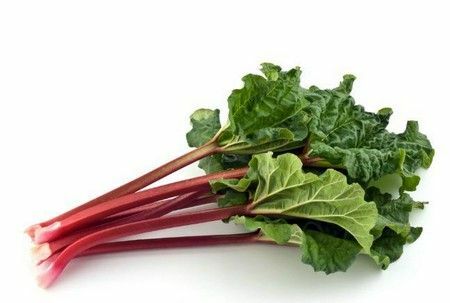 Rhubarb - another delicious "exotic", which came to us from our ancient times. Our ancestors appreciated the healing properties of the root and the excellent palatability of the stems and leaves. The benefits and harm of rhubarb were known back in the time of the first Russian Emperor Peter I, because it was then that this "strategic export product" began to be mined in Western Siberia and sold to Western Europe.
Rhubarb - another delicious "exotic", which came to us from our ancient times. Our ancestors appreciated the healing properties of the root and the excellent palatability of the stems and leaves. The benefits and harm of rhubarb were known back in the time of the first Russian Emperor Peter I, because it was then that this "strategic export product" began to be mined in Western Siberia and sold to Western Europe.
However, in the history of rhubarb in Russia there are many mysteries. The well-known version that he was brought from Asia by NN Przheval'skiy is not quite true - the traveler actually delivered seeds of Tangut rhubarb to the St. Petersburg Botanical Garden, but this is just one of its varieties! The Russian word "rhubarb" dates back to the Turkish( or Persian) ravent , and the first mention of the trade in this plant by historians was found in the memoirs of G. Kotoshikhin, created in the 1660s.
Botanical classification refers this early perennial to the buckwheat family. In nature there are up to 30 varieties of "heroic grass": medicinal, fingered, wavy, hybrid, Tatar, southern, Black Sea, currant, rock. .. In our country grows a rhubarb Altai( otherwise compact), which is famous for its fortifying properties.
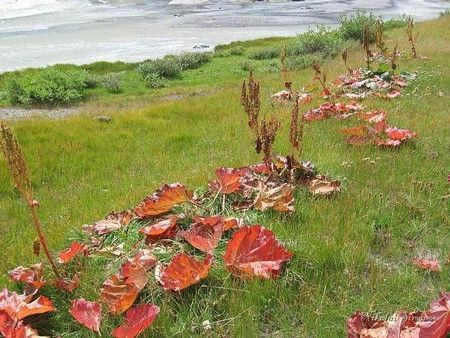
. Accordingly, the use of rhubarb for the organism differs depending on the place of its growth - its properties are so different. So, ordinary rhubarb is found next to "burdock and swan" in the overgrown corners of the garden, and there are also valuable medicinal species that grow in China and Tibet. Here of them, the ancient herbalists, a few thousand years ago, distinguished "an excellent yellow root," which was used as a medicine with antipyretic effect.

Now the rhubarb has spread all over the planet - and is actively used in cooking, homeopathy, pharmaceuticals. It's hard to believe, looking at the photo, that the rhubarb, now becoming something of a "dietary delicacy", is so easy to grow on your site!
Tip: Young leaves and tender petioles are considered edible for the sake of which the rhubarb is specially planted in the shade or in a special way treated with a hollow opaque container( a bucket or a barrel without a bottom is the so-called English method).Then the stems of the plant stretch towards the light and the long petioles grow faster. Collect rhubarb should be until the middle of June, until the stalks are not rough and have not accumulated unsafe for the body oxalic acid.
The healing properties of rhubarb: both tops and roots!
How useful is the rhubarb? First of all, the value for human health is fresh spring greens, which can diversify the meager diet in early spring and cope with avitaminosis. Vitamins, which the body needs during this period, will help it rebuild after the winter and strengthen the immune defense.
Treasures of
This plant can rightly be called a storehouse of vitamins and mineral compounds. Useful properties of rhubarb are due to such a unique chemical composition. So, the leaves are rich in vitamin C, bioflavonoids, ergosterol, iron salts, oxalic and malic acids.
In the petioles of large leaves there is carotene, vitamins C, K, E, PP, B1, B2, dietary fiber( 3.2%), apple, citric, succinic, oxalic and acids( up to 3.5%), fatty acids,pectins( up to 1.5%), sugar( 2%), tannins, potassium salts, iron, phosphorus, calcium, sodium, magnesium, trace elements. The useful properties of the plant is that 100 grams of rhubarb stems are only 16 kcal, which allows it to be used in dietology.
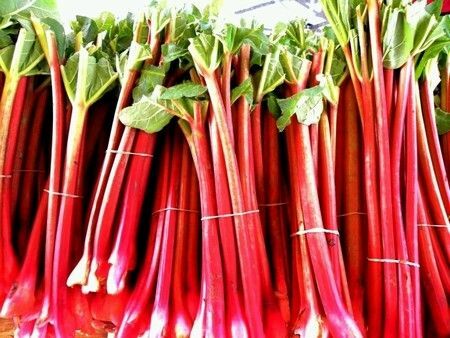
. The root of the plant contains glycoside chrysophane, chrysarobine, chrysophone and oxalic acid, tannins, starch, various resins.
Using the roots of
A powerful rhubarb root, sometimes reaching 9-10 kg, is a real find for homeopaths and herbalists. The most valuable are Asian wild-growing varieties of plants. The root must have reddish, white and yellow veins;preparations from it taste bitter( due to the presence of glycoside chrysophane), with a specific odor. The roots of a 3-4-year-old plant are most suitable for therapeutic purposes.
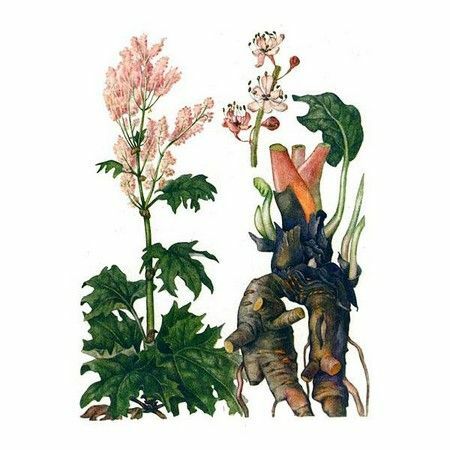
. The preparations from rhubarb roots( infusions, decoctions, syrups, extract, powder, tablets) have the following application in medicine and cosmetology:
- digestion improvement, getting rid of indigestion;
- antimicrobial and anti-inflammatory effects in inflammation of the stomach;
- is a gentle laxative and cleansing action, used for weight loss and constipation treatment;
- is an appetizing, choleretic, remedy for liver diseases;
- is a fortifying agent for anemia, sclerosis and pulmonary diseases;
- treatment of burns, psoriasis;
- antiscorbutic properties;
- firming and coloring agent for hair alone or mixed with henna( powder).
Tip: For harvesting raw materials, you need to dig in the fall rhizomes of the plant, clean them from the ground and small roots, rinse, cut into small pieces and dry at a temperature of up to 60 ° C.You can store such raw materials for up to 5 years.
Powder prepared from roots can be brewed and consumed as tea. Also, powdered rhubarb root is used in decoction from hepatitis.
Recipe for decoction from hepatitis
It will be required: rhubarb root powder - 2 tbsp, water - 0.5 l.
Preparation: Pour the powder with boiling water, boil over low heat for 20 minutes. Pan with a decoction wrap and leave for 10 hours, then drain the liquid
Take a decoction before eating 1 tbsp.3 times a day, eating 1 tsp.honey. When treating a child, the portion of the broth should be reduced to 1 tsp. The course of treatment is 1 month.
Prescription for infusion of anemia, poisoning, tuberculosis
It is required: 1 tbsp.roots, 1 glass of water.
Preparation: Pour raw rhubarb with cold water, leave for 8 hours( overnight), then bring to a boil and boil for 3 minutes.
Take the drug 70-80 ml to three times a day.
Prescription laxative remedy based on rhubarb root
It is required: 20 g of dry raw material, 200 ml of boiling water
Preparation: Pour the roots with water, boil for 10 minutes, cool.
To achieve a laxative effect, take 150-200 ml at night.
Cautions and contraindications
Powder from rhubarb root has a different effect on the body. Thus, small doses of up to 0.5 g serve as a fixative and cholagogue preparation, and large doses( up to 2 g) will have a laxative effect.
The danger is the content of toxic oxalic acid in the raw materials, even in insignificant quantities, which threatens health, therefore, in spite of the relative safety of preparations based on "heroic herb", rhubarb should be avoided in the following cases:
- inflammation or intestinal obstruction, peritonitis, bleeding instomach and intestines;
- urolithiasis and other kidney diseases;
- rheumatism;
- pregnancy and lactation( allowed, but in small amounts);
- child's age.
And the first, and the second, and compote!
The use of rhubarb in cooking has a long tradition - it is known that recipes mentioning this component are found in old cook books since the XVIII century. What can you cook from rhubarb?
It is known that in the XIX century Altai peasants steamed stems in the oven and ate with honey, or put pies in the filling, or cooked a rhubarb borsch. In the capital's kitchen, they preferred vintage and rhubarb sauce, as well as meat dishes with its addition.
Modern culinary people often come with rhubarb as a fruit - they use jam, jam, sherbet, marmalade, jelly, candied fruit, pudding, jelly and compote to prepare. Tasty stuffing for sweet baked rhubarb is also tasty. In desserts, it successfully combines with strawberries, lemon, apples, cherries, raspberries, and from spices - with cinnamon, ginger, cloves. A wine made from rhubarb resembles the famous French Chablis.
Fresh young leaves and petioles cut into salads. You can even cook green borscht and spring vegetable soups, as this plant successfully replaces sorrel. As a side dish delicious steamed or boiled stems - so the vegetable gains softness and a delicate consistency.
Unusual rhubarb buds, reminiscent of cauliflower, are considered a delicacy in Asian cuisine, they are used as decorations and additions to various dishes.
Dried rhubarb leaves are used as a spicy seasoning for fish dishes.
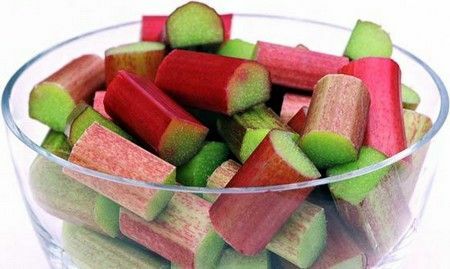
. Tip: Rhubarb leaves contain oxalic acid in a sufficiently high concentration, so the petioles must be separated from the leaves immediately after cutting the plant! From the stems and petioles of rhubarb you can remove the fibrous peel( but it also has useful substances!), And then you can use this sourish taste of the product. The rhubarb stems prepared in this way and packed in a bag are stored in the refrigerator for about a week. Sliced sticks can be frozen for longer storage.
Prescription of the rhubarb soup
It will be required: 500 g rhubarb stalks, lemon crust, 1 l water, 2 tbsp.starch, sugar, vanillin, 250 ml of white wine, 7 biscuits.
Preparation: Diced rhubarb and lemon peel in the water until cooked( 5-10 minutes), rub the rhubarb in mashed potatoes through a sieve, add the diluted starch, sugar to taste, wine, vanillin. When serving, put crushed rusks in a bowl, pour soup, decorate with berries or cherries.
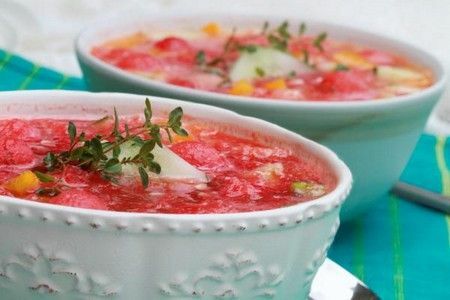
Pork recipe under rhubarb sauce
It will be required: 800 g of pork tenderloin, 3 tbsp.mustard, 250 ml of red dry wine, 300 g of rhubarb, 150 g of sugar, 100 ml of water, salt to taste.
Preparation: Cut pork into small pieces, put out in marinade from wine and mustard for about 1 hour, add salt at the end of cooking. Separately, prepare a rhubarb sauce: boil the petioles in sugar syrup for 5-6 minutes, then pierce the blender to a puree state. Ready pork to lay on a dish, pour with sauce, decorate with greens.
Recipe for a delicious jam
It will be required: 1 kg of rhubarb, 1 kg of sugar.
Preparation: Diced rhubarb with sugar, leave for a day under the lid in the bowl, which is supposed to cook jam. Boil on low heat with constant stirring for 15 minutes. Jam is ready.
Recipe for rhubarb compote for thirst quenching
It will take: 500 g of chopped stems, 2 l of water, 120-150 g of granulated sugar.
Preparation: Place the rhubarb and sugar in a suitable bowl, add water and boil for 5 minutes. Turn off the heat and leave to cool. In the finished compote you can add ice, lemon.
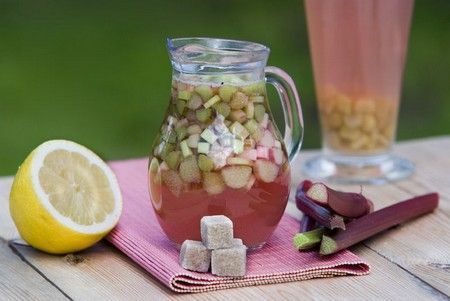
. Tip: To cook rhubarb dishes, use only dishes with a "neutral" surface - stainless steel or with Teflon or ceramic coating.
So, if you do not have contraindications for using this vegetable, then the use of rhubarb for the body will be obvious - it can not only help cure diseases, but also contribute to the preservation of harmony, improve well-being, make gourmets happy.
You can find out about the benefits and harm of rhubarb by watching an interesting video:
